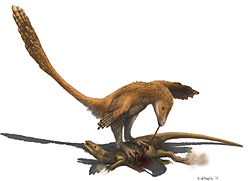| Zephyrosaurus Temporal range: Early Cretaceous, ~ | |
|---|---|
 | |
| Mounted skeleton, Natural History Museum of Berlin | |
| Scientific classification | |
| Kingdom: | Animalia |
| Phylum: | Chordata |
| Class: | Reptilia |
| Clade: | Dinosauria |
| Clade: | † Ornithischia |
| Family: | † Thescelosauridae |
| Subfamily: | † Orodrominae |
| Genus: | † Zephyrosaurus Sues, 1980 |
| Type species | |
| †Zephyrosaurus schaffi | |
Zephyrosaurus (meaning "westward wind lizard") is a genus of orodromine ornithischian dinosaur based on a partial skull and postcranial fragments discovered in the Early Cretaceous (Aptian-Albian) Cloverly Formation of Carbon County, Montana, USA. New remains are under description, and tracks from Maryland and Virginia, also in the US, have been attributed to animals similar to Zephyrosaurus.

